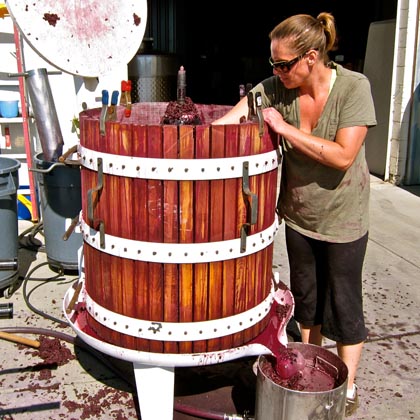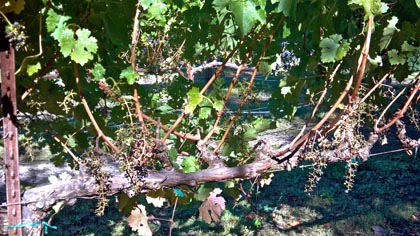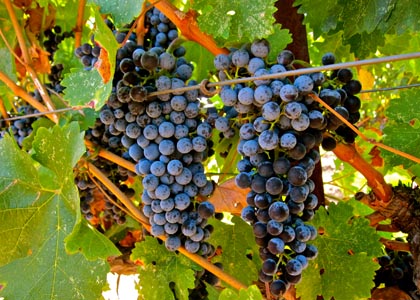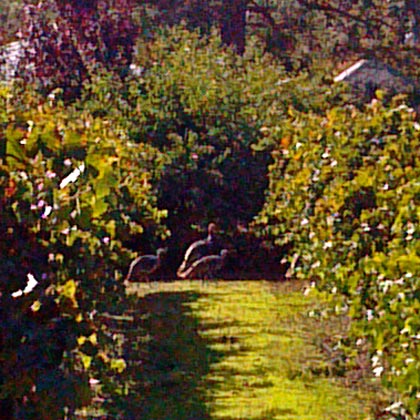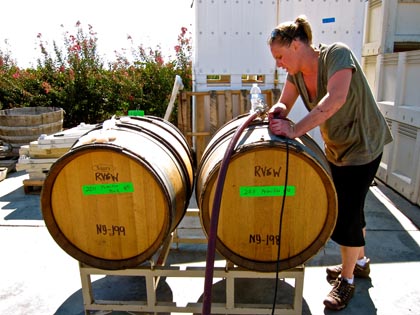Letters from Lodi
An insightful and objective look at viticulture and winemaking from the Lodi
Appellation and the growers and vintners behind these crafts. Told from the
perspective of multi-award winning wine journalist, Randy Caparoso.
Lodi harvest in October 2011
Ripken Vineyards' Susan Ripken, pressing juice from skins of her fermented 2001 Primitivo -- like most of Lodi's Zinfandel, picked well before rains
We often forget that wine is basically an agricultural product, which is why any winegrower will tell you: Mother Nature always has the last word. Even so, sometimes it has nothing to do with weather…
Mettler vines, picked clean by turkeys
Last week, as he was out in the fields analyzing Cabernet Sauvignon grapes being grown for the Mettler Family label, Adam Mettler noticed a few rows with grape bunches completely stripped of berries. “We are constantly battling Mother Nature in some blocks,” says Mettler, “but in this case, the culprit wasn’t rain or temperature… these rows were eaten by turkeys!”
Otherwise, the story of the second half of the harvest 2011 in Lodi is that two passing rains and a few days of humidity did cause some issues during the second week of October; resulting in some red wine grapes picked at lower than desired sugar levels in order to avoid rampant bunch rot.
But not all of it. Mettler reports that over a quarter of the Cabernet Sauvignon for the Mettler program was picked before the first rain on October 5. “Those grapes came in at about 26.5° Brix,” says Mettler, and are “looking really good already, sitting at about 15.3% alcohol. But surprisingly, the Cabernet Sauvignon still out in the vineyards, post-rain, is also looking good” – ironically, because there were some issues traceable to last spring.
Mettlers' Arbor Vineyards Cabenet Sauvignon, 2011
“Our Cabernet crop level is lower than normal,” Mettler explains, “given the very spaced out clusters, which are loose because of the poor set in the spring” – referring back to the post-flowering period when seeds and berries first began to form on the vines. Last spring’s sub-par set may have resulted in a lighter crop load, but because of that, “sugars are actually in better shape than pretty much all the other late ripening varieties.” Mother Nature may take something away, but sometimes she gives back.
Turkeys caught red-handed
Some of the Mettlers’ remaining Cabernet Sauvignon blocks may have lost a half a point in sugar readings after the second rain (last week), says Mettler, but “we are not noticing much, if any, methoxypyrazine in any block.” Methoxypyrazine being the vegetal or bell peppery component indicative of poorly ripened Cabernet Sauvignon. “We are going to hold tight for another week to ten days,” say Mettler, “to try to build up phenolic concentration.”
By the time the first October rain came, more than 95% of Lodi’s Zinfandel – a grape notoriously susceptible to bunch rot – was already picked and safely tucked away in the fermenters. That said, according to Mettler, “Petite Sirah became the biggest concern for us in October.”
When the weather turned humid, degradation in much of the Petite Sirah took place at a faster rate than sugar increase, “so we had had to lower our usual sugar standards and turn a blind eye to some physical appearance in order to timely get this crop into the winery. The resulting wines, however, are showing promise, even at much lower alcohol and structure than what we usually get.”
Susan Ripken pumping pressed Primitivo to barrels
Meanwhile, while watching Susan Ripken press off fully fermented Primitivo – which she says was picked before the rain with “no bunch rot… everything good and consistent” – we learned that the Ripken family still had some Petite Sirah, Tinta de Toro (a clonal variant of Tempranillo), Grignolino, and Trincadeira (a little known, but highly prized, grape of Portuguese origin) out in the fields, waiting to be picked.
Speaking of which: Ron Silva, Lodi’s “Portuguese grape king” at Silvasprings Vineyards, reports that most of his specialty grapes – like Touriga Nacional, Tourgia Francesa, Tinta Cão, and Souzão – are being picked this week (October 16-22), which he says is “unusual because Touriga and Souzão are usually the last ones to come in. Although they are not as high in Brix as past years, they are fully ripened.”
Maybe that’s because Mr. Silva is naturally a nice guy – and it’s always smart to be nice to Mother Nature…
Ripken Primitivo on vine, September 2011
